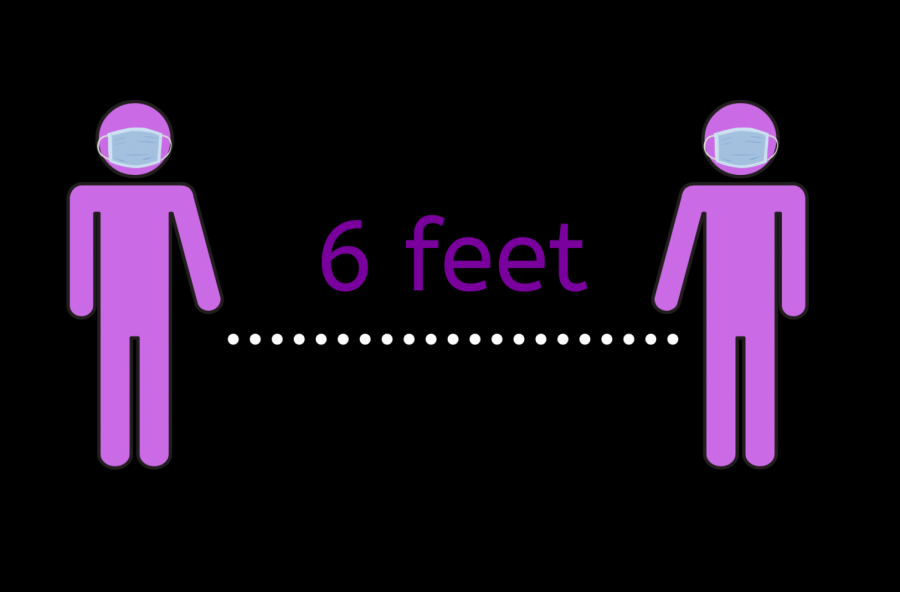Editorial: There’s a reason for social distancing
Photo credit: Nicki Rosenberg
Due to the spread of COVID-19, social distancing is necessary to slow the development of the virus. Although it may be difficult, the Editorial board encourages practicing social distancing at all times during this pandemic.
April 12, 2020
Instead of beaches, skiing and relaxing with friends, this year’s spring break has been full of sleeping, hand sanitizer and most importantly, social distancing. Because of the COVID-19 outbreak causing people to remain quarantined and distanced from others, there will be lost time with friends and possible cancellations or postponements of momentous events such as prom, graduation and other highly anticipated traditions. Although this new normal is extremely difficult to face, it is imperative that we follow the restrictions put in place.
So what exactly does social distancing mean, and how will it prevent the outbreak from spreading further?
The CDC defines social distancing as “remaining out of congregate settings, avoiding mass gatherings, and maintaining distance (approximately 6 feet) from others when possible.” COVID-19 spreads through respiratory droplets when an infected individual coughs or sneezes, so person-to-person contact makes it much easier for the virus to circulate. Anyone nearby can inhale the droplets into the lungs, which will spread the disease. The virus can also be contracted by coming into contact with contaminated objects or surfaces.
While those with symptoms are the main cause of the spread, it is important that everyone participates in cautionary measures, as many may have the virus without showing any signs. If individuals, symptomatic or not, decrease their contact with one another through social distancing, the spread of the virus will not escalate as quickly and many lives will be saved. Another key action people can take is wearing face masks. On April 7, Los Angeles Mayor Garcetti announced that all residents must wear a face-covering (mask, scarf, bandana, etc.) while visiting essential businesses like grocery stores to protect more people and slow the spread of the coronavirus.
While the acts of social distancing and wearing face masks will not completely annihilate the virus, we need them because it decelerates the spread of the disease to manageable numbers that do not overwhelm our medical centers. We need social distancing in place across America for months to slow the number of new infections. This will give us the time to make plans for a more targeted mitigation strategy and ultimately make things right.
Without a vaccine or cure for the virus, social distancing may be the most effective way for people who aren’t infected with the coronavirus to avoid getting it. But it does lead to some major changes in how businesses are run, public events are held and social interactions occur. In many places, state and local governments have authorized shelter-in-place orders to encourage social distancing. This includes the closure of non-essential businesses and the cancellation of mass gatherings like concerts, festivals and even schools all around the world.
This won’t last forever, and fast and portable tests are on the horizon, but even after we come out of isolation, some level of social distancing will also still need to remain in our daily lives. It is likely that we will have to take a step-by-step procedure to move away from social distancing and re-integrate normal behavior with a healthy balance of cautionary actions to best eradicate the virus. Until then, especially because there are so many things about this virus that are unknown, it is important that we stay put.
The most obvious way to practice social distancing is to avoid public places and close contact with others. But for most people, especially those who thrive on social interaction, it is near impossible to completely isolate oneself. If this is the case, taking walks around your neighborhood (while maintaining a 6-foot distance from others), face timing, texting and calling is the best way to stay active and connected with others.
This may be easier said than done, and it’s not easy to endure the lack of human connection in the face of such sacrifice and adversity. So it is extremely important to use this challenging time to make positive changes and learn the tools necessary to do so. Use this time to do face masks, work out, learn to cook, read tons of books, call your family and enjoy the downtime you will likely never experience again. It is especially important that during a time as difficult as this that you find ways to prioritize your mental health. Some helpful tools include yoga, meditation, dancing or even just talking to friends.
The greatest power we have right now is patience. This too shall pass, but our world needs to make a conscious and collective effort in order for that to happen. Stay safe, stay healthy and stay home.










